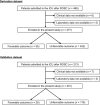Development of a prompt model for predicting neurological outcomes in patients with return of spontaneous circulation from out-of-hospital cardiac arrest
- PMID: 29123717
- PMCID: PMC5667257
- DOI: 10.1002/ams2.96
Development of a prompt model for predicting neurological outcomes in patients with return of spontaneous circulation from out-of-hospital cardiac arrest
Abstract
Aim: Early prediction of the neurological outcomes of patients with out-of-hospital cardiac arrest is important to select the optimal clinical management. We hypothesized that clinical data recorded at the site of cardiopulmonary resuscitation would be clinically useful.
Methods: This retrospective cohort study included patients with return of spontaneous circulation after cardiopulmonary resuscitation who were admitted to our university hospital between January 2000 and November 2013 or two affiliated hospitals between January 2006 and November 2013. Clinical parameters recorded on arrival included age (A), arterial blood pH (B), time from cardiopulmonary resuscitation to return of spontaneous circulation (C), pupil diameter (D), and initial rhythm (E). Glasgow Outcome Scale was recorded at 6 months and a favorable neurological outcome was defined as a score of 4-5 on the Glasgow Outcome Scale. Multiple logistic regression analysis was carried out to derive a formula to predict neurological outcomes based on basic clinical parameters.
Results: The regression equation was derived using a teaching dataset (total, n = 477; favourable outcome, n = 55): EP = 1/(1 + e-x ), where EP is the estimated probability of having a favorable outcome, and x = (-0.023 × A) + (3.296 × B) - (0.070 × C) - (1.006 × D) + (2.426 × E) - 19.489. The sensitivity, specificity, and accuracy were 80%, 92%, and 90%, respectively, for the validation dataset (total, n = 201; favourable outcome, n = 25).
Conclusion: The 6-month neurological outcomes can be predicted in patients resuscitated from out-of-hospital cardiac arrest using clinical parameters that can be easily recorded at the site of cardiopulmonary resuscitation.
Keywords: Cardiopulmonary arrest; logistic regression; neurological outcomes; prediction; return of spontaneous circulation.
Figures



Similar articles
-
Comparison of the factors affecting neurological outcome in out-of vs in-hospital cardiac arrest cases.J Pak Med Assoc. 2016 Nov;66(11):1412-1417. J Pak Med Assoc. 2016. PMID: 27812058
-
Association between cardiopulmonary resuscitation duration and one-month neurological outcomes for out-of-hospital cardiac arrest: a prospective cohort study.BMC Anesthesiol. 2017 Apr 21;17(1):59. doi: 10.1186/s12871-017-0351-1. BMC Anesthesiol. 2017. PMID: 28431508 Free PMC article.
-
Impact of Early Vasopressor Administration on Neurological Outcomes after Prolonged Out-of-Hospital Cardiac Arrest.Prehosp Disaster Med. 2017 Jun;32(3):297-304. doi: 10.1017/S1049023X17000115. Epub 2017 Feb 22. Prehosp Disaster Med. 2017. PMID: 28222830
-
Prediction of neurological outcomes following the return of spontaneous circulation in patients with out-of-hospital cardiac arrest: Retrospective fast-and-frugal tree analysis.Resuscitation. 2018 Dec;133:65-70. doi: 10.1016/j.resuscitation.2018.10.002. Epub 2018 Oct 4. Resuscitation. 2018. PMID: 30292802
-
Prehospital cardiopulmonary resuscitation duration and neurological outcome after out-of-hospital cardiac arrest among children by location of arrest: a Nationwide cohort study.Scand J Trauma Resusc Emerg Med. 2019 Aug 23;27(1):79. doi: 10.1186/s13049-019-0658-7. Scand J Trauma Resusc Emerg Med. 2019. PMID: 31443673 Free PMC article.
Cited by
-
External validation of cardiac arrest-specific prognostication scores developed for early prognosis estimation after out-of-hospital cardiac arrest in a Korean multicenter cohort.PLoS One. 2022 Apr 1;17(4):e0265275. doi: 10.1371/journal.pone.0265275. eCollection 2022. PLoS One. 2022. PMID: 35363794 Free PMC article.
References
-
- Peberdy MA, Callaway CW, Neumar RW et al Part 9: post‐cardiac arrest care: 2010 American Heart Association Guidelines for Cardiopulmonary Resuscitation and Emergency Cardiovascular Care. Circulation 2010; 122: S768–786. - PubMed
-
- Bernard SA, Gray TW, Buist MD et al Treatment of comatose survivors of out‐of‐hospital cardiac arrest with induced hypothermia. N. Engl. J. Med. 2002; 346: 557–563. - PubMed
-
- Hypothermia after Cardiac Arrest Study Group . Mild therapeutic hypothermia to improve the neurologic outcome after cardiac arrest. N. Engl. J. Med. 2002; 346: 549–556. - PubMed
-
- Oda Y, Tsuruta R, Kasaoka S, Inoue T, Maekawa T. The cutoff values of intrathecal interleukin 8 and 6 for predicting the neurological outcome in cardiac arrest victims. Resuscitation 2009; 80: 189–193. - PubMed
LinkOut - more resources
Full Text Sources
Other Literature Sources

